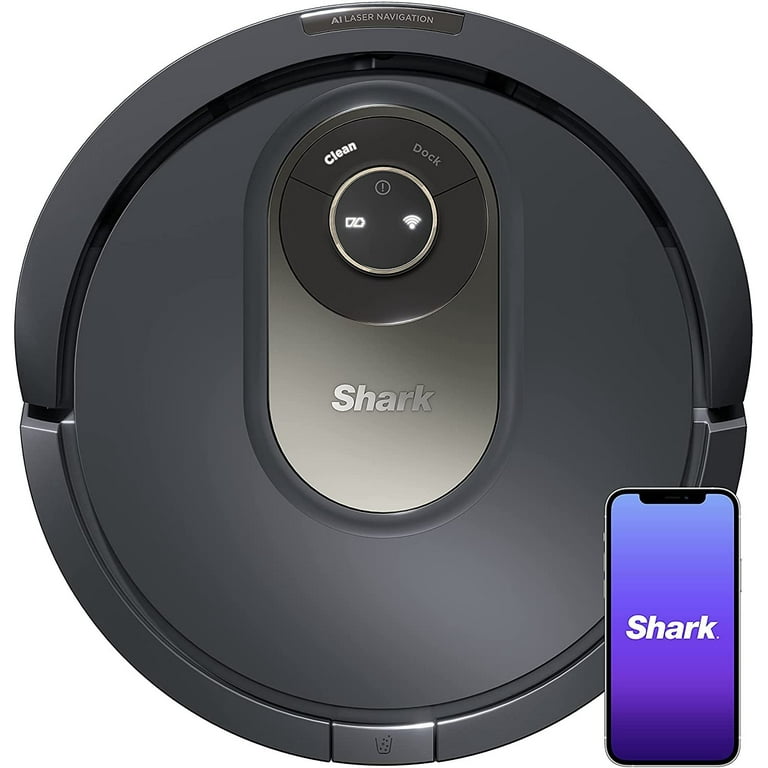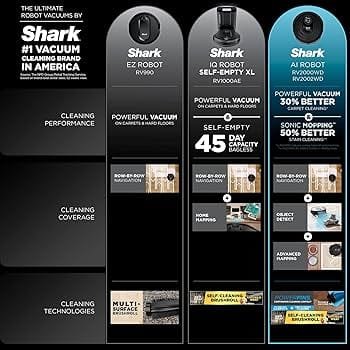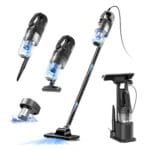Vacuum cleaners are essential for keeping homes clean. With AI technology, their performance has improved.
AI technology brings a new level of efficiency to vacuum cleaners. These smart vacuums can map out your home, avoiding obstacles and ensuring every corner is clean. They learn the layout, adjust their cleaning paths, and even adapt suction power based on the floor type.
This means better cleaning with less effort from you. AI vacuums also offer convenient features like scheduled cleaning and remote control through apps. As AI continues to evolve, we can expect even more intelligent and efficient cleaning solutions. Let’s explore how AI technology is transforming vacuum cleaners and making our lives easier.

Credit: www.amazon.com
Ai-powered Sensors
AI technology is transforming the way vacuum cleaners operate, and at the heart of this revolution are AI-powered sensors. These sensors are like the vacuum’s brain, helping it make smart decisions and react to its environment. Let’s dive into how these sensors improve vacuum performance, focusing on real-time adjustments and enhanced navigation.
Real-time Adjustments
Imagine your vacuum automatically adjusting its suction power based on the type of floor it’s cleaning. AI-powered sensors make this possible. They can detect changes in floor type and modify the vacuum’s settings on the fly.
This means your vacuum won’t waste energy on hard floors or struggle with carpets. It’s a game-changer, especially if you have a mix of flooring in your home. You get optimal cleaning without lifting a finger.
Ever noticed how some vacuums seem to miss spots? With AI sensors, that’s a thing of the past. They can detect where dirt is concentrated and focus more effort on those areas. You end up with a cleaner home, with less effort.
Enhanced Navigation
Navigating around furniture and obstacles can be a challenge for traditional vacuums. AI-powered sensors help vacuums navigate more intelligently. They can map out your room and create an efficient cleaning path.
This means fewer random bumps into furniture and more thorough coverage of your floors. It’s like having a little robot that knows your home as well as you do.
Have you ever seen your vacuum get stuck under furniture? AI sensors can prevent this. They can measure the height of obstacles and avoid places where the vacuum might get trapped. It’s all about making your life easier.
Next time you see your vacuum zipping around your home, think about the smart technology inside it. AI-powered sensors are making vacuums smarter and your home cleaner. What will they think of next?

Credit: www.walmart.com
Smart Mapping
Smart Mapping is a groundbreaking feature in modern vacuum technology. It allows vacuums to learn and adapt to your home’s layout. This means more efficient and thorough cleaning. Let’s dive deeper into how Smart Mapping works and benefits you.
Accurate Floor Plans
AI technology creates precise floor plans of your home. The vacuum uses sensors to navigate and map each room. It remembers the layout for future cleaning sessions. This ensures no spot is missed.
The accurate floor plans help the vacuum avoid obstacles. It identifies furniture, walls, and other barriers. This reduces the chances of collisions and damage. Your vacuum cleans efficiently and safely.
Customized Cleaning Paths
With Smart Mapping, you can set customized cleaning paths. You decide which areas need more attention. You can also set no-go zones. This flexibility allows the vacuum to focus on high-traffic areas.
Customized paths save time and energy. The vacuum only cleans where necessary. This targeted approach improves performance and extends battery life. You get a cleaner home with less effort.
Advanced Suction Control
Advanced suction control has become a key feature in modern vacuum technology. This smart functionality ensures that vacuums operate efficiently. They adapt to various floor types and dirt levels. Let’s explore how AI technology enhances vacuum performance through advanced suction control.
Adaptive Suction Levels
AI technology allows vacuums to adjust suction power automatically. This means the vacuum can detect the type of surface. For example, it will use higher suction on carpets. It will reduce suction on hard floors. This ability ensures optimal cleaning on any surface.
The vacuum learns from its environment. It adapts over time to improve performance. This reduces the need for manual adjustments. Users experience consistent cleaning results. This adaptive feature saves time and effort. It makes vacuuming more effective and less of a hassle.
Energy Efficiency
AI-controlled suction reduces energy consumption. The vacuum uses only the power needed for each task. This helps in conserving battery life. It also lowers electricity usage. Users benefit from cost savings on energy bills.
Energy-efficient vacuums are more eco-friendly. They contribute to reducing carbon footprints. This is a great advantage for environmentally conscious users. Smart energy use extends the vacuum’s lifespan. It reduces wear and tear on the motor and other components.
Overall, advanced suction control improves vacuum efficiency. It ensures better cleaning, saves energy, and adapts to user needs. This makes modern AI vacuums a smart choice for any home.
Obstacle Detection
AI technology has significantly improved vacuum performance, especially in the area of obstacle detection. This innovation ensures your vacuum can navigate around your home efficiently, avoiding obstacles and maintaining a thorough clean. Let’s delve deeper into how AI enhances this aspect of vacuuming.
Avoiding Furniture
One of the most noticeable improvements is the vacuum’s ability to avoid furniture. Traditional vacuums often bump into chairs, tables, and other household items, causing potential damage and inefficient cleaning patterns.
AI-powered vacuums use sensors and cameras to map your home. They can identify and remember the locations of your furniture, ensuring they clean around them without making contact.
Imagine not having to worry about your vacuum scratching your favorite coffee table. AI technology makes this possible, creating a safer environment for both your furniture and your vacuum.
Handling Unexpected Objects
Unexpected objects like toys, shoes, or even a stray sock can be challenging for traditional vacuums. They often get stuck or tangled, halting the cleaning process.
AI technology enables vacuums to recognize and adapt to these unexpected obstacles. Advanced algorithms allow the vacuum to either navigate around the object or gently push it aside without causing damage.
This means fewer interruptions and a more seamless cleaning experience. You can leave items out without worrying about your vacuum getting stuck or damaged.
Have you ever found your vacuum stuck on a stray sock? With AI technology, those days are over. Your vacuum becomes smarter, more efficient, and better at adapting to your home.
User-friendly Interfaces
AI technology has brought a wave of innovation to everyday appliances, including vacuum cleaners. One of the standout features is the user-friendly interfaces that make operating these high-tech devices a breeze. Modern vacuums are not just about powerful suction—they’re about making your life easier.
Voice Commands
Imagine telling your vacuum to start cleaning while you’re cooking dinner. AI-powered vacuums come equipped with voice command capabilities. You can sync them with smart home systems like Amazon Alexa or Google Assistant.
Instead of fiddling with buttons, you simply say, “Alexa, start vacuuming.” It’s convenient and adds a touch of futuristic flair to your routine. This hands-free operation is perfect when multitasking or when you have your hands full.
Mobile App Integration
Most AI vacuums now offer mobile app integration. This means you can control your vacuum cleaner from your smartphone, no matter where you are. Forgot to clean up before guests arrive? Just open the app and start the vacuum remotely.
The apps often come with features like scheduling, monitoring cleaning progress, and even setting up virtual boundaries for the vacuum. This way, you have complete control over your cleaning schedule. It’s not just about convenience; it’s about giving you more time to focus on what really matters.
These user-friendly interfaces are transforming how we interact with our household appliances. Have you tried using voice commands or mobile apps with your vacuum? How has it changed your cleaning routine?
Efficient Scheduling
Imagine a vacuum that knows exactly when to clean your home without you lifting a finger. Efficient scheduling is one of the standout features of AI technology in modern vacuum cleaners. It ensures your floors are spotless while you focus on more important tasks.
Optimized Cleaning Times
AI-powered vacuums analyze your cleaning needs and set the perfect time to clean. They learn your daily routine and adjust their schedule accordingly. For example, if you usually leave for work at 8 AM, the vacuum will start cleaning shortly after you leave.
This means you come home to a clean house every day. They avoid cleaning during times when you are likely to be home, reducing noise and disruption. Imagine never having to hear the hum of a vacuum while you’re trying to relax!
Routine Adjustments
Life is unpredictable, and your schedule might change. AI vacuums adapt to these changes seamlessly. If you have a day off or a sudden change in plans, the vacuum adjusts its cleaning schedule to suit your new routine.
For example, if you decide to work from home one day, the vacuum will recognize that and reschedule its cleaning time. This flexibility ensures that your home remains clean without interrupting your activities. It’s like having a personal assistant for your floors!
Have you ever thought about how much time you spend managing household chores? With AI technology in your vacuum, you can reclaim that time. Efficient scheduling is one small way AI is making our lives easier and our homes cleaner. How would you spend the extra time you save?
Predictive Maintenance
Predictive maintenance is a significant advancement in AI technology. It enhances the performance of modern vacuum cleaners. This feature helps anticipate potential issues before they become serious problems. By using AI, vacuums can now monitor their own condition. They can alert users about necessary maintenance tasks. This prevents breakdowns and maintains optimal performance.
Proactive Issue Alerts
AI-powered vacuums send proactive issue alerts to users. These alerts notify owners about clogs, filter replacements, or brush roll issues. Users get notified before a problem escalates. This helps in taking timely action to keep the vacuum running smoothly. It reduces the likelihood of unexpected breakdowns.
With predictive maintenance, vacuums provide real-time diagnostics. They analyze data from sensors to detect abnormalities. This technology ensures that any issue is addressed promptly. As a result, users enjoy consistent and reliable cleaning performance.
Extended Lifespan
Predictive maintenance extends the lifespan of vacuum cleaners. Regular maintenance prevents wear and tear. It ensures that all parts function optimally. AI technology helps in scheduling timely maintenance. This keeps the vacuum in top condition for longer periods.
By addressing potential issues early, users can avoid costly repairs. The vacuum’s components last longer, providing value for money. This prolongs the vacuum’s operational life, ensuring it remains efficient. Predictive maintenance makes vacuum ownership more cost-effective and hassle-free.

Credit: www.reemanrobot.com
Eco-friendly Solutions
AI technology enhances vacuum performance by optimizing suction power and detecting dirt types. This leads to efficient and eco-friendly cleaning. Smart sensors in AI vacuums adjust settings automatically, ensuring thorough cleaning with minimal energy use.
Eco-Friendly SolutionsArtificial Intelligence (AI) is not just about making vacuum cleaners smarter; it also plays a significant role in promoting eco-friendly solutions. By improving efficiency and sustainability, AI technology helps you maintain a cleaner home while also caring for the planet. Let’s dive into how AI-driven vacuums contribute to a greener environment.Reducing Waste
AI technology in vacuum cleaners helps in reducing waste significantly. Smart sensors detect the amount of dirt and adjust the suction power accordingly. This means the vacuum only uses the energy it needs, which leads to less power consumption.I remember when I upgraded to an AI-powered vacuum, I noticed a drop in my electricity bill. It felt great knowing I was reducing my carbon footprint without sacrificing cleanliness.Furthermore, AI vacuums often come with washable and reusable filters. This reduces the need for disposable filters, cutting down on waste. Have you ever thought about how much waste you generate with traditional vacuum filters? Switching to AI can make a big difference.Sustainable Practices
AI-powered vacuums promote sustainable practices in several ways. Many models are designed to be more durable, reducing the need for frequent replacements. This longevity means fewer vacuums end up in landfills.Manufacturers are also focusing on using eco-friendly materials. Some AI vacuums are made from recycled plastics, aligning with sustainable practices. Next time you shop for a vacuum, consider its environmental impact.Additionally, AI technology ensures that your vacuum operates at optimal efficiency. This means it cleans better and faster, reducing the time and energy spent on cleaning. Imagine cutting your cleaning time in half while also saving energy. Sounds like a win-win, right?What steps are you taking to make your home cleaning routine more eco-friendly? AI technology in vacuums might just be the solution you need.Frequently Asked Questions
Are Robot Vacuums Improving?
Yes, robot vacuums are improving. They now offer better navigation, stronger suction, and advanced features like smart mapping.
How Will You Improve The Efficiency Of The Vacuum Cleaner?
Clean the filters regularly and check for clogs. Empty the dustbin frequently. Ensure the brush roll is free of debris. Use the correct settings for different surfaces. Proper maintenance enhances efficiency.
What Is A Vacuum In Ai?
A vacuum in AI refers to an environment with no external factors or noise. It is used for testing algorithms.
What Was The First Ai Vacuum Cleaner?
The first AI vacuum cleaner was the Electrolux Trilobite, introduced in 2001. It was a pioneering robotic vacuum.
Conclusion
AI technology significantly enhances vacuum performance. It makes cleaning easier and more efficient. Better navigation allows vacuums to cover more areas. Sensors help detect dirt and adjust suction power. Users save time and energy with smarter cleaning routines. AI-enabled vacuums adapt to different floor types smoothly.
These advancements provide a cleaner home with less effort. Investing in an AI-powered vacuum is a wise choice for modern households.





